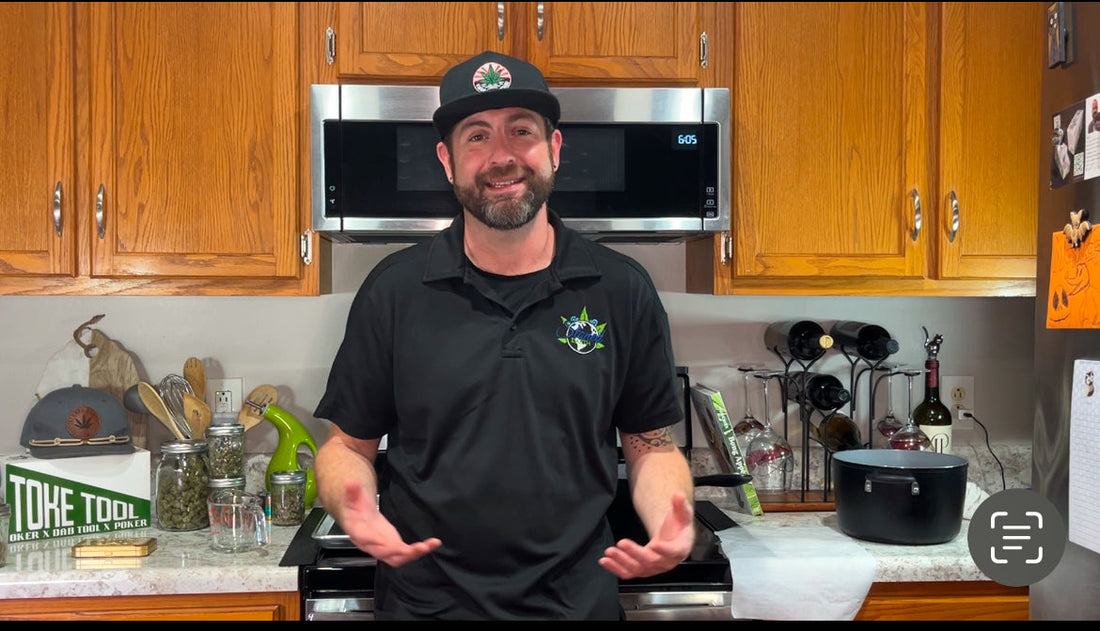
Start Cooking with Cannabis: Introduction
This is the first in a series of articles intended to introduce anyone to the joys of cooking with cannabis. Our goal is to provide you with the information you need to start with zero knowledge and finish by crafting incredible, elevated plates at home. It really is simple!
We just have to add two steps before we cook our recipes:
Decarb > Infuse > Cook
We prep the weed, infuse it in our fatty medium (butter, oil, or cream), then use that medium in our dishes. Once we have these ready, we can start cranking out some of the delectable recipes The Heady Chef crafts and shares with us. For the uninformed, The Heady Chef is an award-winning chef and cofounder of Stoned Earth. He began his culinary journey at the Connecticut Culinary Academy, graduating salutatorian of his class before taking over as Chef de Partie at a Michelin-starred kitchen in Lombardy, Italy. He returned to America under the tutelage of James Beard-winning chefs before becoming the Chef de Cuisine at some of the finest establishments in New England.
The cannabis game isn’t what it was five, 10, 20-plus years ago. Every aspect of it has evolved with technological advances and the changing legal landscape. This is no more evident than in the edible cannabis realm. We’ve gone from lazily decarbing bud in brownie batches to sweet confectionary-style edibles using distillate, to newer advanced extraction methods that have opened the door for all sorts of treats with quicker activation methods. This series of blogs is here to help you begin your cooking with cannabis journey at home with little-to-no specialized equipment.
At its core, creating any food with cannabis involves transferring active THC molecules from the plant material to the edible medium as efficiently as possible. There are many different ways to accomplish this but the end goal is the same - turn cannabis flowers into something you want to eat that will allow you to experience its effects. This can be accomplished through infusion, active isolation, distillation, nano-emulsification, Rick Simpson’s full-spectrum oil (RSO) technique, and many others. For our purposes of cooking at home with cannabis, we are primarily focusing on infusion methods.
Why? It’s simpler to do at home and provides the base for 90% of the food-based recipes we can conjure up. There’s basically two steps: decarbing and infusion. Let’s get a little sciency, shall we?
Decarbing your stash
To start cooking with cannabis, it is important to understand the decarboxylation process (or at least know why it’s important). We go into it a little more in-depth in the next article of the series - Start Cooking with Cannabis: How to Decarb Your Weed.
Cannabis plant material contains delta-9-tetrahydrocannabinolic acid - THCA. It has a lot of the benefits associated with cannabis consumption but is not psychoactive. It won’t get you high. It’s the precursor to THC. In order to experience the psychoactive benefits of consuming cannabis, the THCA in the cannabis must be heated until the carboxyl group acid is broken down through a process known as decarboxylation, which creates delta-9-tetrahydrocannabinol (the THC we’re all familiar with).
When we burn flower with a flame or dab it into a hot banger, this decarboxylation happens immediately as we consume it. However, the plant material itself is completely consumed in the process. To use our stash for cooking, we must heat it to a point that decarboxylation occurs but not so much that the cannabinoids cook-off or the plant material combusts. This can be done in an oven, the chamber of a vaporizer, a decarbing machine, or several other ways.
Any mention of THC in these blogs refers to delta-9-tetrahydrocannabinol obtained by submitting raw cannabis flower to a decarboxylation technique.
Infusion: We want FAT
THC molecules are made for fats. They readily absorb into fats while avoiding water (logKow coefficient of approx 7 on a scale of -3 to 10, per NIH). Think of the fact that THC remains detectable in our bodies for so long compared to other substances - it stores in our body fat. While this chemical property may not be great for pre-employment screening purposes at some archaic, non-inclusive companies, it’s awesome for cooking at home.
Because THC molecules are so highly fat-soluble, they are great for infusion into fatty foods such as oil, butter, and cream. By first decarbing our weed and then infusing it into a fat, we reach the goal we talked about previously - achieve a high THC molecule transfer to the foods we want to eat. That’s it!
Imagine all of the dishes that use butter, oil, or cream!
Continue the series:
Start Cooking with Cannabis: Why and How to Decarb Your Flower
Start Cooking with Cannabis: How to Make CannaCream
Start Cooking with Cannabis: How to Make CannaCream using AVB

